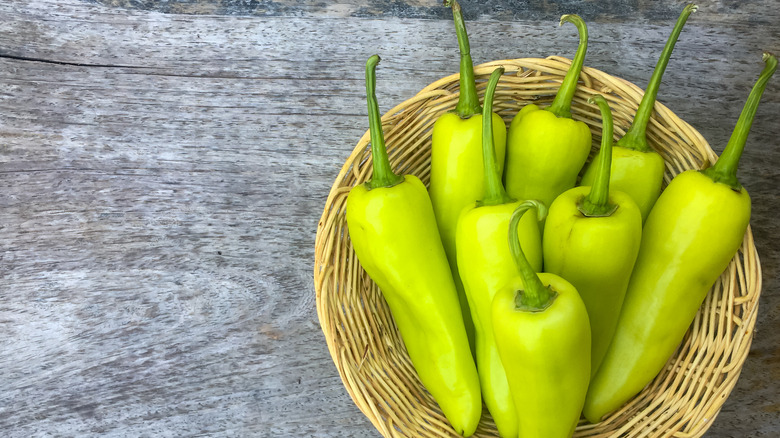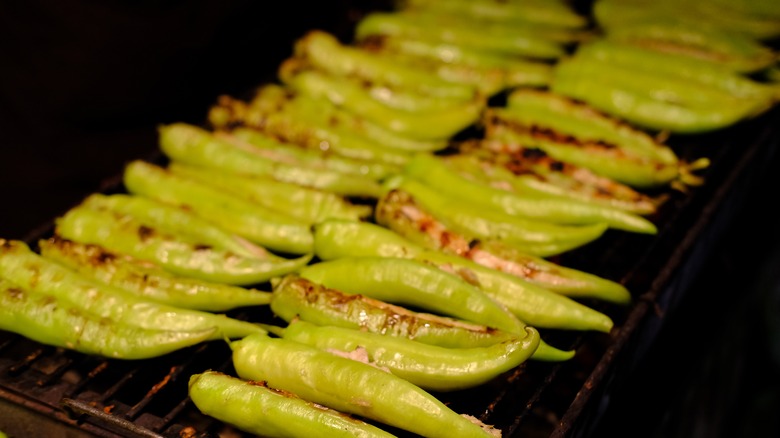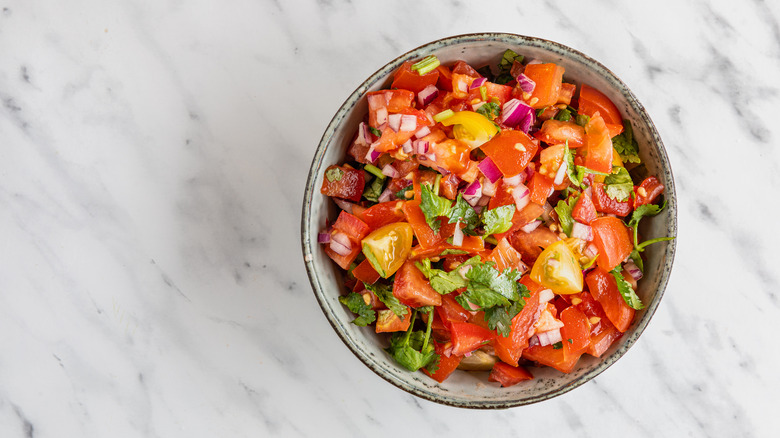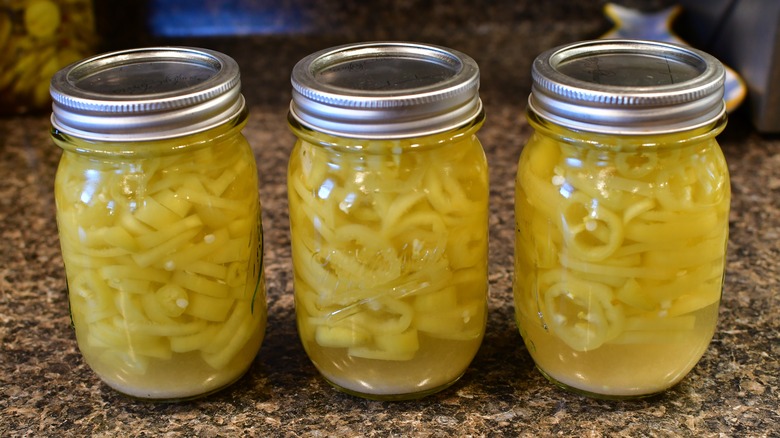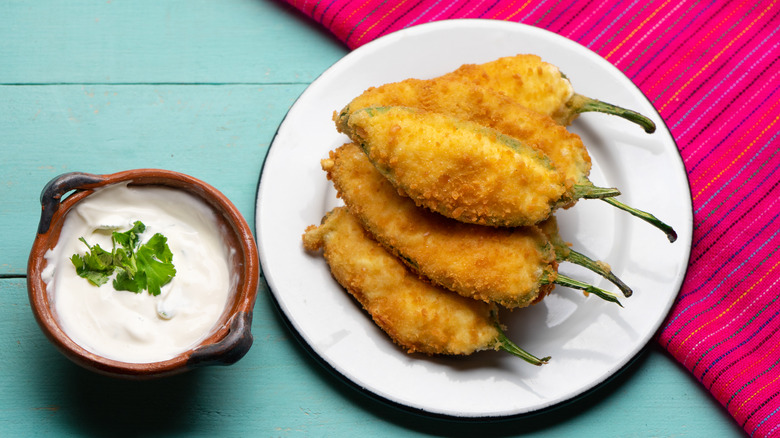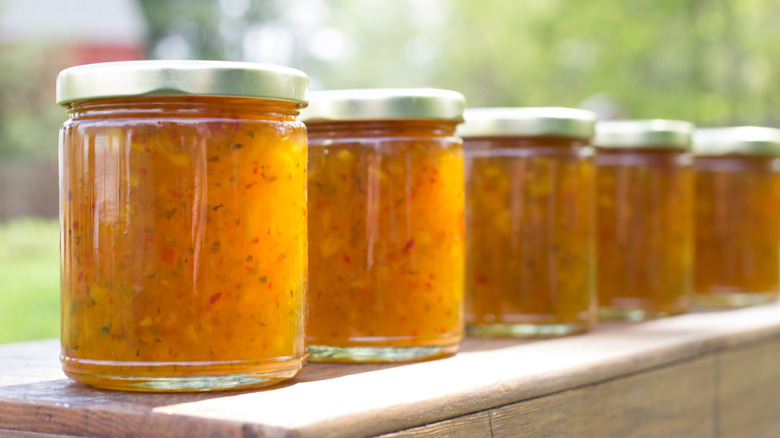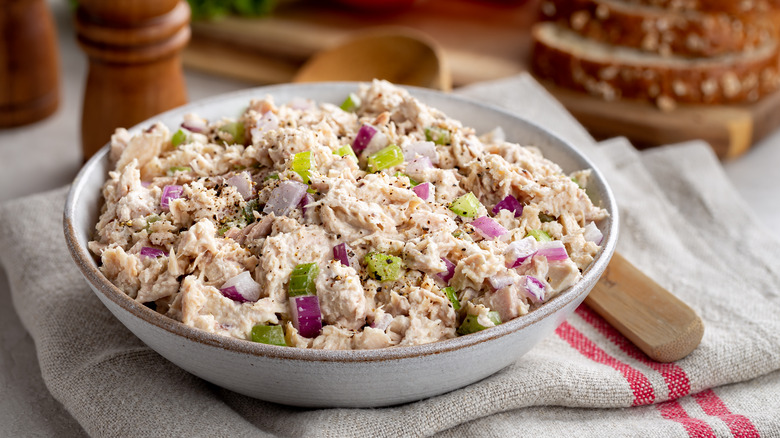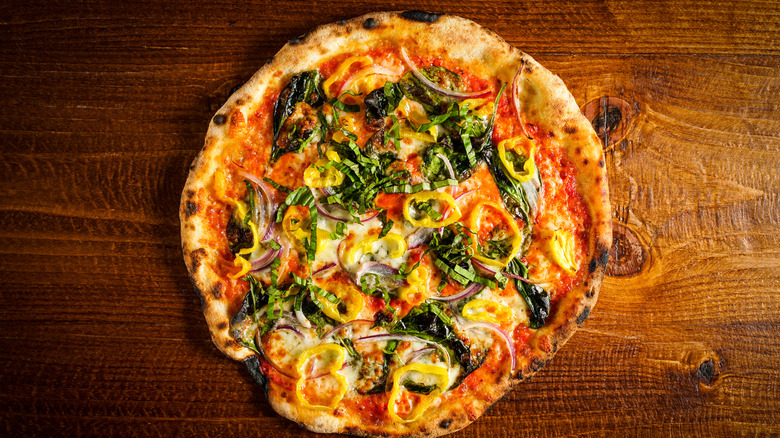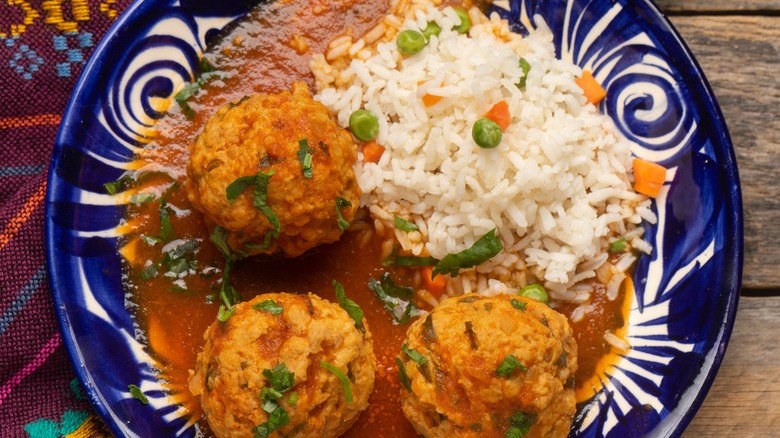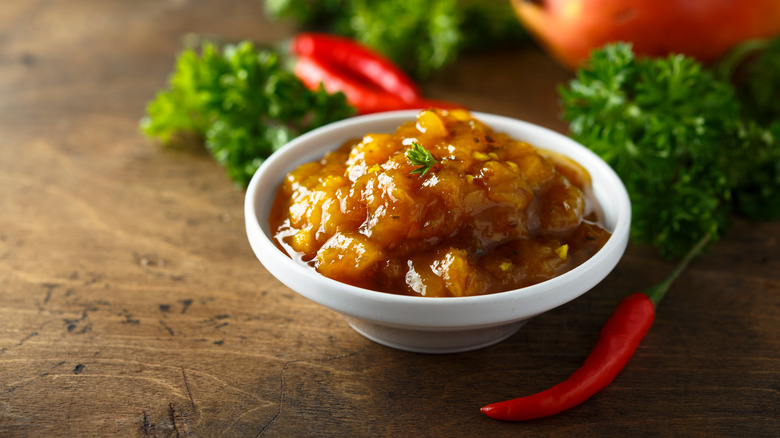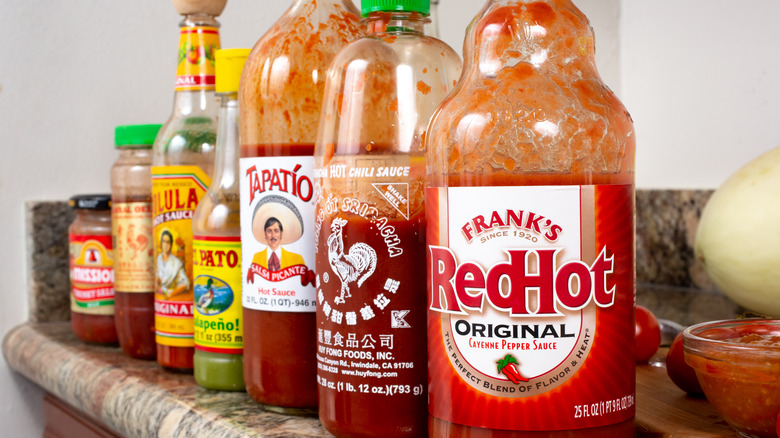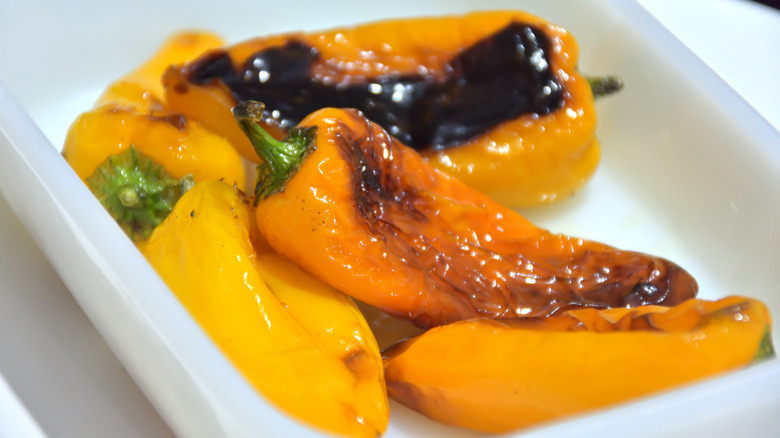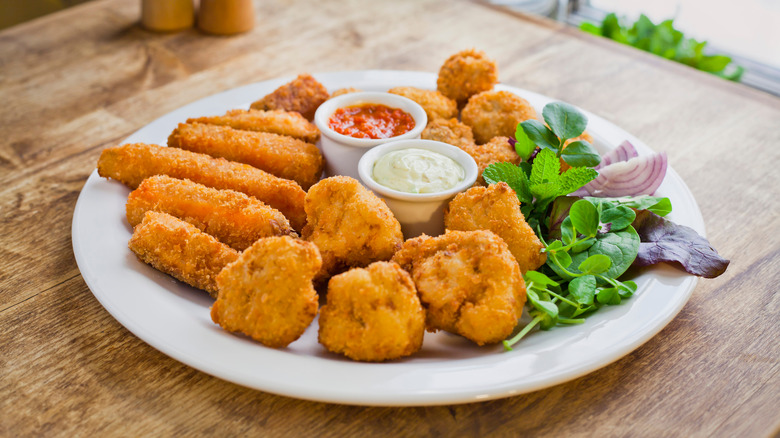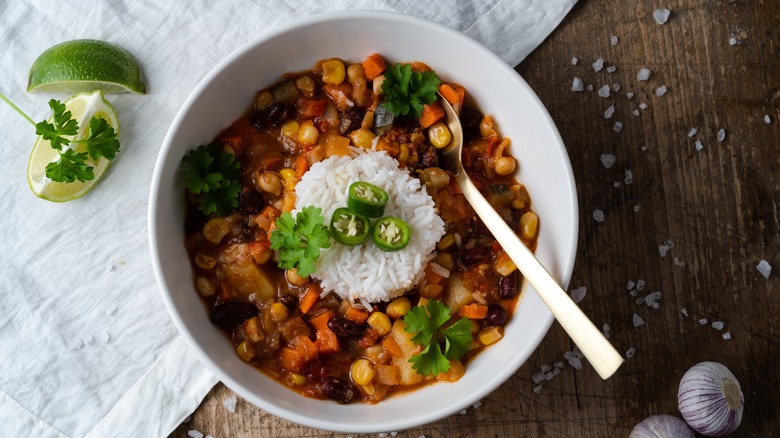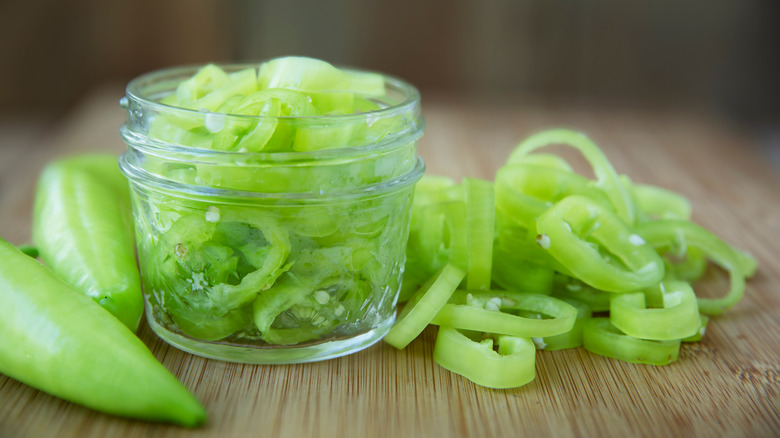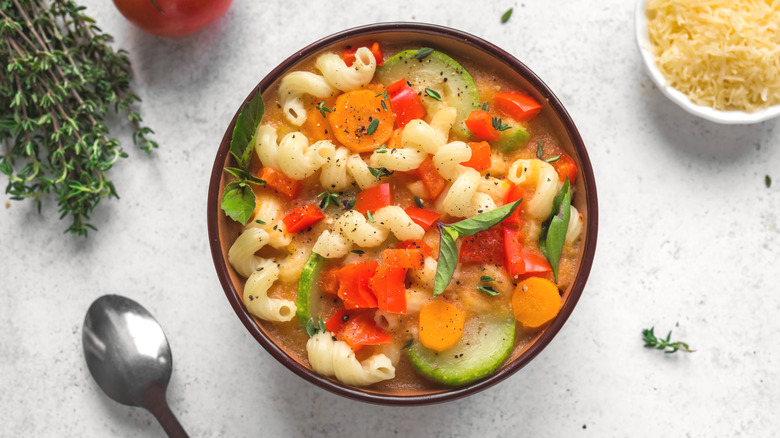15 Unique Ways To Use Banana Peppers
We may receive a commission on purchases made from links.
Banana peppers are yellow peppers that have a mild tangy flavor. They are part of the capsicum annuum family of peppers, and their only connection to bananas is their curved shape and bright color. These mild yellow peppers are sweeter than other peppers and only register on the Scoville heat scale a mere 0-500; for comparison, jalapeño peppers register between 2,500-8,000 (via PepperScale).
Due to banana peppers' shape and color, they are often confused with peperoncinos which share a similar mild, tangy flavor profile. Both peppers are sold pickled and can easily be swapped for each other without too much change to the final dish.
However, according to PepperScale, if you make the mistake of confusing them with their other doppelganger, the Hungarian wax pepper, you will be in for a surprise, as the Hungarian wax pepper is much hotter at about 7,500 on the Scoville scale.
You may have tried banana peppers at your local sandwich shop as they are a popular sandwich topper, but they can do more than just elevate cold cuts. Banana peppers are versatile and can be smoked, stuffed, and grilled, just to name a few ways to use these peppers. If you like a little zing without the heat, check out other ways these peppers can enhance your weekly menu. They are packed with vitamin C and low in calories, making them the perfect pepper to add to your daily diet (via WebMD).
Stuffed peppers
Classic stuffed peppers, usually made with mild bell peppers, are an easy dish that wow in presentation. If you are looking for a creative way to liven up the classic dish with something new, try swapping bell peppers for banana peppers instead. Of course, banana peppers are smaller, which would make them perfect for an appetizer or side dish. Their sweet flavor adds to a savory minced meat filling. Or add a smoky pork filling to contrast the sweet banana peppers; you can never go wrong with that sweet, smoky combo.
If you prefer your stuffed peppers without meat, try a mix of rice or quinoa with savory herbs and spices to get a unique stuffed pepper experience. According to Meatless Monday, just one person giving up animal protein one day a week for one whole year eliminates car emissions equal to driving 348 miles. So try stuffing your banana peppers with healthy grains on Mondays in a quest to lower your carbon footprint — and tangy stuffed banana peppers are an excellent way to ditch the meat for the day without sacrificing the flavor.
Salsa
Move over ketchup; there is a new spicy sheriff in town: Salsa. Salsa has overtaken the United States and, according to Business Insider, is the number one condiment in America. It is easy to understand why salsa is the perfect condiment. While it's a mandatory addition to many popular Mexican foods like tacos and burritos, it's also excellent on breakfast eggs, steak, and even as a salad dressing. Not to mention salsa comes in many varieties, from hot and spicy to sweet and smoky, from smooth to chunky the possibilities are endless. So why not use banana peppers to make salsa?
These mild yellow peppers add a zesty zing to a tomato-based salsa without adding too much heat. And if the heat is what you are after, combine banana peppers with one of their hotter cousins for a super special salsa. Just remember, if you are cutting hotter peppers like jalapeños or colorful habaneros, use gloves and remove the seeds. De-seeding your peppers is the best way to get their flavor without burning your face off.
Pickled peppers
Did you know you can pickle almost any vegetable? Yes, you can pickle any semi-hard vegetable like carrots, cabbage, beans, beets, and of course, banana peppers. And pickled banana peppers are a tangy treat. Pickled peppers are probably the most common way to eat banana peppers. You have probably seen them as a veggie option right next to the lettuce and tomatoes at your local sandwich shop because they add a nice tasty zing to a sandwich. In the supermarket, you will find them near the pickles, and they will probably share a shelf with the similar-looking and tasting pepperoncino.
Pickling is the process of preserving foods with a simple mix of salt, water, and vinegar. But there is another way to get that tanginess, and that is fermentation. Fermentation or lactic acid fermentation is a process that achieves the same results with a simple brine of only salt and water. Pickled banana peppers from the store are always pickled, but if you want the same zesty flavor with added health benefits and powerful probiotics, then you should lacto-ferment your banana peppers at home. All you need is salt, water, banana peppers, a jar, and a little time. According to Healthline, lacto-fermented foods have a host of health benefits, and they make it easy to get more vegetables like banana peppers into your diet.
Banana pepper poppers
Jalapeño poppers are a game day favorite, spicy on the inside and crunchy on the outside with a creamy, cheesy middle; they are the perfect food to wash down with a fizzy drink. If you are hosting a game night and have some guests on your list that don't do spicy, try swapping out jalapeño peppers for banana pepper poppers. Banana peppers have the same texture as jalapeños, but without the heat. And structurally, banana peppers are sturdy enough to hold a cream cheese filling and a batter so you can deep fry them to perfection.
If you love poppers but don't love the added calories of deep frying, try swapping out the batter and oil and instead wrap your banana pepper poppers in a salty strip of bacon. It will save you some calories while still tasting like a decadent treat. To really fancy up your poppers, swap cream cheese for pungent blue cheese for added potency.
Pepper jelly
A classic way to use banana peppers is to make a southern favorite, pepper jelly. Pepper jelly is a unique blend of sweet and hot in a spreadable jelly form. There are many different easy-to-make pepper jelly recipes. Some recipes call for hot habaneros and jalapeño combinations for a more hot than sweet jelly, while others use mild bell and banana peppers for a sweeter finish. Each family has their own unique approach to pepper jelly, and it is a great way to use up your summer crop of banana peppers.
The most common way to enjoy pepper jelly is simply on a cracker with some cream cheese; the velvety cheese is the perfect match for the smoky pepper jelly. Opt for the fancy crackers, and you have yourself an elegant appetizer that will impress your guests. But pepper jelly isn't just for crackers; use it as a marinade for chicken or fish, mix it with salad greens to give a boring salad a kick, or add it to a stir fry. It's easy to make at home, and if you put it in cute jars, it's a great gift for the foodies in your life.
Tuna salad
There are two types of tuna lovers in this world; those that like tuna salad simple with only mayo and those who like their tuna salad packed with crunchy, salty, savory bits like pickles, peppers, onions, and celery. If you fall into the second category, then banana peppers are an excellent addition to your favorite tuna salad sandwich. Finely chop fresh banana peppers with onions for extra crunch, or mince pickled banana peppers with dill pickles for a briny tuna salad experience. Either way, those banana peppers are going to add something special to a classic tuna salad.
If you aren't sure which type of tuna salad person you are, then make both and find out. According to the American Heart Association, eating two servings of fish per week is an excellent way to add more protein and healthy fats to your diet. They suggest fatty fish for the most health benefits and that list includes tuna. So whichever type of tuna salad person you are, you can feel good about adding tuna to your menu.
Pizza topping
C'mon, everybody loves pizza. It is one of those foods that, even if it's bad, it's still good. The most popular pizza toppings in the United States are pepperoni, sausage, and mushrooms (via YouGov). These pizzas may be popular, but they are so basic. Pizza should be treated like a work of art, pizza dough is like a canvas, and you can paint with your favorite vegetables, cured meats, and even seafood to create your own masterpiece.
Adding banana peppers to your pizza is an excellent addition. Pickled or fresh banana peppers have a distinct tangy flavor that plays well with spicy sausage, earthy mushrooms, salty olives, sweet sun-dried tomatoes, and other toppings. Banana peppers are an ensemble player. They don't need to be the star of the show, but they add something special, and combined with other tasty toppings, they create a unique flavor profile.
For die-hard pepperoni lovers that refuse to give up on their classic pizza, step out of your flavor comfort zone by adding some banana peppers to your pepperoni pizza. Expand your palate in baby steps. And enjoy!
Pepper meatballs
Meatballs are one of those foods that can be prepared in many different ways. The humble meatball is a mix of bits of ground meat with breadcrumbs and vegetables and bound with an egg. They are so easy to put together and customize you can make meatballs with any ground meat.
Meatballs are also the perfect disguise for vegetables. Once cooked and covered in a hearty sauce, picky diners won't even know that the tasty little ball of goodness may have some grated carrots, zucchini, or chopped banana peppers inside. Traditionally, meatballs were a peasant food made with a mix of whatever was cheap and on hand, so adding vegetables like banana peppers isn't that strange of an idea (via The Atlantic).
The best way to disguise vegetables in meatballs is to finely chop them so they can easily mix in with the blend of ground meat, herbs, and spices. If your diners are not adverse to vegetables, then chop your banana peppers coarsely to add more texture to your meatballs — and don't forget the sauce.
Banana pepper chutney
Is it relish? Jam? Sauce? Salsa? No, it's chutney. Chutney is not just one thing it's more like a mix of things. It comes from Indian cuisine, and it can be sweet, savory, creamy, nutty, you name it, and there is probably a chutney made from it. Chutneys are made with fruit or vegetables, spices, sugar, and vinegar (via Food Reference). Sometimes they are thin, like a dipping sauce, but they can also be chunky. The spice and heat level also varies. Some chutneys can set off a five-alarm fire in your mouth — others lean to the mild and sweet side. You can mix them in rice or spread them on bread or dip your favorite snack in them; when it comes to chutney, there really are no hard rules.
Banana peppers make an excellent chutney. Their natural mild, tangy flavor combines well with fruit for a sweet chutney. But banana peppers can also hold their own when combined with hot peppers for a sweet and hot chutney. You can find chutneys at most grocery stores near the condiments or international foods. Or you can try your hand at making a banana pepper chutney at home.
Hot sauce
While not as popular as salsa, hot sauce is still a crowd favorite. Hot sauce is made with a combination of chiles like habanero, jalapeño, cayenne, and ghost peppers. While the key to hot sauce is heat, there are a lot of interesting hot sauces on the market, like fruity blueberry habanero and sweet mandarin chipotle hot sauce.
Making hot sauce with banana peppers is a natural step toward hot sauce infusions. Combining fresh banana peppers with their hotter cousins is one way to get a hot sauce going. Banana peppers' natural flavors will complement the other peppers to give a more nuanced flavor rather than just hot.
Another way to use banana peppers to make the hot sauce is to buy jars of hot pickled banana peppers. While they are generally sold pickled in jars, they also sell jars of banana peppers in a spicy brine. Use those peppers mixed with your favorite combination of fruity, sweet, or savory add-ins for a unique hot sauce. And when you run out of peppers, don't throw out that brine; that spicy brine is an excellent base for a new hot sauce combination.
Blackened peppers
Charring vegetables is an age-old cooking technique where intense heat is applied to create a nuanced flavor. Don't make the mistake of thinking charred foods are burned while they might look burned or blackened; they are perfectly safe to eat. The difference between charred foods and burnt foods, according to MasterClass, is "timing and intention." Intentionally creating char on vegetables brings out more of their flavor and creates a new texture. And banana peppers are perfect for charring.
The best way to char banana peppers is in a dry skillet or on a grill. The key is obviously the high heat but also turning frequently to avoid crossing the line into burnt. It's a delicate dance to get the perfect char. When charring any type of pepper, including banana peppers, it is recommended to remove them from heat once charred to perfection, then remove the seeds and blackened skin and place them in the refrigerator to cool. From there, you can make them into salsa or sauce or just drizzle on some olive oil and enjoy.
Deep fried banana peppers
Deep-fried vegetables are common in the south, from fried green tomatoes to fried okra; the southern tradition of frying up tasty vegetables is a culinary tradition. So it's no surprise to see deep-fried banana peppers on a diner's plate in the south.
Luckily you don't have to cross the Mason-Dixon line to get your hand on some fried banana peppers; they are easy to make at home. You can make them with fresh banana peppers which are everywhere in the summer months, or with jars of pickled banana peppers when fresh ones are scarce. Either way, remove the seeds before deep frying them, as they tend to be bitter.
If you have never batter fried at home for fear that it's just too messy, there are a few tricks to make it easier. The best way to keep the mess down is to have three separate bowls — one for milk, one for flour, and one for your breading. Then, make sure to keep one hand dry and only use that for the dry part of dredging, and the other hand is the wet hand responsible for the wet dredging. It's a simple cooking technique that you will be glad you mastered so you can enjoy deep-fried everything.
Chili
On a cold, blustery winter day, a bowl of chili is the best way to warm you up from the inside out. Meat, beans, and vegetables simmering in a thick sauce, chili is an American tradition. There are a lot of ways to make chili; go to any chili cookout, and you will see lots of different versions of this savory dish. Chili was born in Texas, where it is recognized as the state dish (via State Symbols USA). Some chili purists will argue if it has beans, it's not really chili at all. Whether you make your chili with beans or without, you can definitely add vegetables like tomatoes and peppers to make a hearty chili.
Many chilies use bell peppers because their mild taste blends well with other ingredients without overpowering the rest of the dish. But banana peppers are a great alternative if you are looking for a way to get your chili to stand out from the rest. You will want to use fresh banana peppers to keep the texture and add a unique twist on this hearty bowl of goodness.
Candied peppers
Sometimes called cowboy candy, candied peppers are not a treat for the faint of heart. They are somehow spicy, sweet, and sour all at the same time. Candied peppers are the brainchild of a little girl in Texas in 1922 who was looking for a way to use up an overabundance of jalapeños from the family garden (via Cowboy Candy).
Traditionally candied peppers are made with jalapeños which are responsible for the intense flavor experience. But replacing jalapeños with banana peppers is a great way to make use of banana peppers. Using banana peppers will remove some of the heat that jalapeños supply, but that heat will be replaced by the tangy sourness that banana peppers bring to the table. Think of candied banana peppers as sweet and sour candy.
You might be wondering exactly how to enjoy these unique candied peppers, and the answer is simple: Eat them on burgers, hot dogs, sandwiches, wraps, or pizza. Try serving these treats alongside fried fish or chicken fried steak. They also make a great garnish for a Bloody Mary or Margarita. You can even eat them straight out of the jar.
Soup
Soup is always on the menu. It's hearty and healthy and the perfect vehicle for getting more vegetables like banana peppers in your diet. The best way to use banana peppers in soup is to sauté fresh banana peppers with onions and garlic before adding them to a broth. Banana peppers will give your soup a slight tang and chunky texture; they are perfect for a minestrone.
If you prefer a creamier soup, just dust off your immersion blender and blend the banana peppers and other vegetables after they have cooked. This keeps the flavor while losing the chunky texture.
Soup isn't just a healthy dish — it's also good for your mood. Soup is the classic dish associated with feeling down or sick, and there is a reason that soup makes us feel better. According to Psychology Today, eating physically warm foods like soup actually aids in feeling emotional warmth and connection with others. So it's not a myth soup really is good food.
